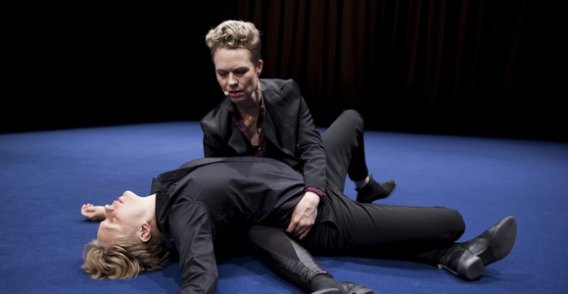Maija Hirvanen’s ”Art & Love”, a German premiere at HAU3 for Tanz im August, is full of challenge but even more charm.
Sitting in the HAU3 foyer awaiting the performance, Finnish choreographer Maija Hirvanen sends us a friendly epistolary introduction to her performance-lecture: “Dear audience member,” she writes. “You came to see ”Art & Love” Great that you are here.” In the following full page, she tells us about the preparation of the work and why this solo – her first in ten years – could not, ultimately, exist as a solo on such a topic. Chiefly, we are given a list of 11 things she wrote down halfway through the process, sprinkles in our imagination which include lines like ”The power of looking lights things up”, ”NO to a gaze that thinks it knows”, ”…love has the political power to not make a big difference between self and other…art has the political potential not to make a big difference between art and life”, and ”Say ‘I love you.’ Spend it, try it, waste it.” Thus, already contemplatively primed, we step into ”Art & Love”: a long, dark narrow space flanked with stage curtains bearing just a hint of bureaucracy, a deep blue carpet which muffles sound, and a sharply lit white podium.
Over the next hour and a quarter we are led through a series of inquiries into love. Beginning with erotic ”lizard love” we move to mother love, sibling love, and love between friends, before taking an increasingly abstract journey through love of nature, love of, through, and by images, and love of objects. What unites and underlines each of the inquiries is the concept of practice, both in the exercises Hirvanen demonstrates with a clarity that makes repeating them at home truly possible, but also more fundamentally as a way of being: for example, the practice of loving something by a repeated, and often habitual, attention turned on that thing. An example: Hirva-nen breaks her face into a fake grin. When she does this repeatedly, she tells us, she eventually wants to really grin, to genuinely smile. Hirvanen touches the ground, the podium, the micro-phone. If she touches enough things enough times, she tell us, then eventually she will become ”someone who touches things”. In this way, Hirvanen tells us, motherly love functions. We laugh at this surprising statement, which seems both a provocation and yet somehow, relatably, both the case, and a relief. Love is magical, she seems to say, but not always in the ways we pretend it is.
Magic, in ”Art & Love”, comes in other guises. For example, the power of gathering all of our gazes to look at a single glass, which, under such pressure, becomes an object, nearly fluid in its form, vibrating with magnetism, mystique, power, elusiveness. Magic also comes through the back, we find. Love amongst small families of two or three people is too tight; therefore, we must expand our familial circles. One way to do so, we learn, is through getting more siblings, which, luckily, can be easily done through a straightforward, if soul-searching, activity. In essence, Hirvanen tells us, two persons sit down on the ground and put their backs together and push as hard as they can while thinking of all of the struggles they have gone through in their lives. While listening to a song. And once this exhausting and slightly surreal task is complete, the two are joined for life as siblings.
Part-way through the work, Hirvanen’s assistant, Hannah Ouramo, who has since mostly been serving as physical prop and water pourer, steps up to the podium to read a series of letters written to Hirvanen in response to her invitation to strangers (arranged through friends) to become friends-for-life by contract. The letters are hilarious, unique, bemusing. One is fancifully troubled by what-ifs (”What if we don’t like each other? What if we fall in love?”); another is worried they are simply a tool for art (but acquiesce anyway); yet another simply replies ”Friendship is the salt of the earth” and joins up. Here Hirvanen gently lets us glimpse the thrilled, hesitant, daring, and practical sides of ourselves in relation to others.
It would be tempting to say that Hirvanen’s work is reminiscent of The Symposium, albeit a fresh, contemporary take, but there is something so pure feeling and genuine about the work—a mix of full imagination, exactitude, surprise, and earnestness—that makes it totally different in kind and in spirit. Rather, we are presented with visions of love that are both charming and challenging, destabilizing the topsoil of our usual narratives to make room for fresh sprouts beneath. In this way, Hirvanen’s ”Art & Love” proves a precious piece which offers us a shifted perspective and thus an opportunity for renewal. Art and love.




